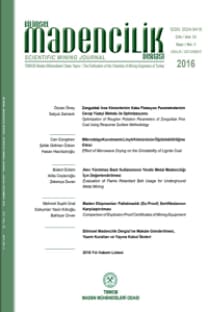Turbulence models and simulation method in the CFD simulation of 75-mm hydrocyclone
Turbulence models and simulation method in the CFD simulation of 75-mm hydrocyclone
___
- Brennan, M.S., Narasimha, M., Holtham, P.N. 2007. Multiphase modelling of hydrocyclones - prediction of cut-size. Minerals Engineering 20, 395- 406. doi:10.1016/j.mineng.2006.10.010.
- Cui, B., Zhang, C., Wei, D., Lu, S., Feng, Y. 2017. Effects of feed size distribu- tion on separation performance of hydrocyclones with different vortex finder diameters. Powder Technology 322, 114-123. doi:10.1016/j. powtec.2017.09.010.
- Delgadillo, J.A., Rajamani, R.K. 2005. A comparative study of three turbu- lence - closure models for the hydrocyclone problem. International journal of mineral processing 77(4), 217-230. doi:10.1016/j.min- pro.2005.06.007.
- Delgadillo, J.A. 2006. Modelling of 75- and 250-mm hydrocyclones and ex- ploration of novel designs using computational fluid dynamics Ph.D. thesis. Utah: The University of Utah.
- Delgadillo, J.A., Rajamani, R.K. 2007. Exploration of hydrocyclone designs using computational fluid dynamics. International Journal of Mineral Processing 84, 252-261. doi:10.1016/j.minpro.2006.07.014.
- Delgadillo, J.A., Rajamani, R.K. 2009. Computational fluid dynam- ics prediction of the air-core in hydrocyclones. Internation- al Journal of Computational Fluid Dynamics 23(2), 189-197. doi:10.1080/10618560902724893.
- Ghadirian, M., Hayes, R.E., Mmbaga, J., Afacan, A., Xu, Z. 2013. On the simu- lation of hydrocyclones using CFD. The Canadian Journal of Chemical Engineering 91(5), 950-958. doi:10.1002/cjce.21705.
- Ghodrat, M., Qi, Z., Kuang, S.B., Ji, L., Yu, A.B. 2016. Computational inves- tigation of the effect of particle density on the multiphase flows and performance of hydrocyclone. Minerals Engineering 90, 55-69. doi:10.1016/j.mineng.2016.03.017.
- Hsieh, K.T. 1988. Phenomenological model of the hydrocyclone. Ph.D. the- sis. Utah: The University of Utah.
- Jiang, L., Liu, P., Zhang, Y., Yang, X., Wang, H., Gui, X. 2019. Design boundary layer structure for improving the particle separation performance of a hydrocyclone. Powder Technology 350, 1-14. doi:10.1016/j.pow- tec.2019.03.026.
- Kuang, S.B., Chu, K.W., Yu, A.B., Vince, A. 2012. Numerical study of liq- uidgas-solid flow in classifying hydrocyclones: Effect of feed solids concentration. Minerals Engineering 31, 17-31. doi:10.1016/j.mi - neng.2012.01.003.
- Li, Y., Liu, C., Zhang, T., Li, D., Zheng, L. 2018. Experimental and Numerical Study of a Hydrocyclone with the Modification of Geometrical Struc- ture. The Canadian Journal of Chemical Engineering 96, 2638-2649. doi:10.1002/cjce.23206.
- Mangadoddy, N., Vakamalla, T.R., Kumar, M., Mainza, A. 2019. Computation- al modelling of particle-fluid dynamics in comminution and classifica- tion: a review. Mineral Processing and Extractive Metallurgy 129(2), 145-156. doi:10.1080/25726641.2019.1708657.
- Narasimha, M., Brennan, M., Holtham, P.N. 2012. CFD modeling of hydro- cyclones: Prediction of particle size segregation. Minerals Engineering 39, 173-183.
- Padhi, M., Mangadoddy, N., Sreenivas, T., Vakamalla, T.R., Mainza, A.N. 2019. Study on multi-component particle behaviour in a hydrocyclone classi- fier using experimental and computational fluid dynamics techniques. Separation and Purification Technology 229, 115698. doi:10.1016/j. seppur.2019.115698.
- Padhi, M., Kumar, M., Mangadoddy, N. 2020. Understanding the bicompo- nent particle separation mechanism in a hydrocyclone using a com- putational fluid dynamics model. Industrial & Engineering Chemistry Research 59(25), 11621- 11644. doi:10.1021/acs.iecr.9b06747.
- Perez, D., Cornejo, P., Rodriguez, C., Concha, F. 2018. Transition from spray to roping in hydrocyclones. Minerals Engineering 123, 71-84. doi:10.1016/j.mineng.2018.04.008.
- Silva, D.O., Vieira, L.G.M., Barrozo, M.A.S. 2014. Optimization of design and performance of solid-liquid separators: A thickener hydrocyclone. Chemical Engineering & Technology 38(2), 319-326. doi:10.1002/ ceat.201300464.
- Vakamalla, T.R., Koruprolu, V.B., Arugonda, R., Mangadoddy, N. 2016. De- velopment of novel hydrocyclone designs for improved fines classifi- cation Using multiphase CFD model. Separation and Purification Tech- nology 175, 481-497. doi:10.1016/j.seppur.2016.10.026.
- Vakamalla, T.R., Mangadoddy, N. 2019. The dynamic behaviour of a large- scale 250-mm hydrocyclone: A CFD study. Asia-Pacific Journal of Chemical Engineering 14(2), e2287. doi: 10.1002/apj.2287.
- Wang, C., Ji, C., Zou, J. 2015. Simulation and experiment on transitional be- haviours of multiphase flow in a hydrocyclone. The Canadian Journal of Chemical Engineering 93, 1802-1811. doi:10.1002/cjce.22274.
- Ye, J., Xu, Y., Song, X., Yu, J. 2019. Novel conical section design for ultra-fine particles classification by a hydrocyclone. Chemical Engineering Re- search and Design 144, 135-149. doi:10.1016/j.cherd.2019.02.006.
- Zhang, Y., Cai, P., Jiang, F., Dong, K., Jiang, Y., Wang, B. 2017. Understanding the separation of particles in a hydrocyclone by force analysis. Powder Technology 322, 471-489. doi:10.1016/j.powtec.2017.09.031.
- ISSN: 2564-7024
- Yayın Aralığı: 4
- Yayıncı: TMMOB Maden Mühendisleri Odası
Sedanur BAŞ, Taki GÜLER, Selçuk AKTÜRK
TTK’DA UYGULANAN ÖN GERİLMELİ AHŞAP DOMUZDAMI SİSTEMİ
Esma Hacer EVKAYA, Erdoğan KAYMAKÇI
Turbulence models and simulation method in the CFD simulation of 75-mm hydrocyclone
Song Gun KANG, Kwang Chol KİM, Sok Chol RYOM, Jin Hyok Rİ
Kritik Hammaddelerin Geri Dönüşüm ile Döngüsel Ekonomiye Kazandırılması
Ata AKÇIL, Ceren ERÜST ÜNAL, Mediha Demet OKUDAN ALTINDAŞ
Dredging Technology of Placer Deposits in the Far North
Ravil Zinnurovich NAFİKOV, Victor Evgenievich KİSLYAKOV, Aleksandr Konstantinovich KİRSANOV, Ekaterina Vasilevna SHEVNİNA, Anastasiya Olegovna IVANCHUK, Pavel Viktorovich KATYSHEV, Umardzhon Riezidinovich TESHAEV
